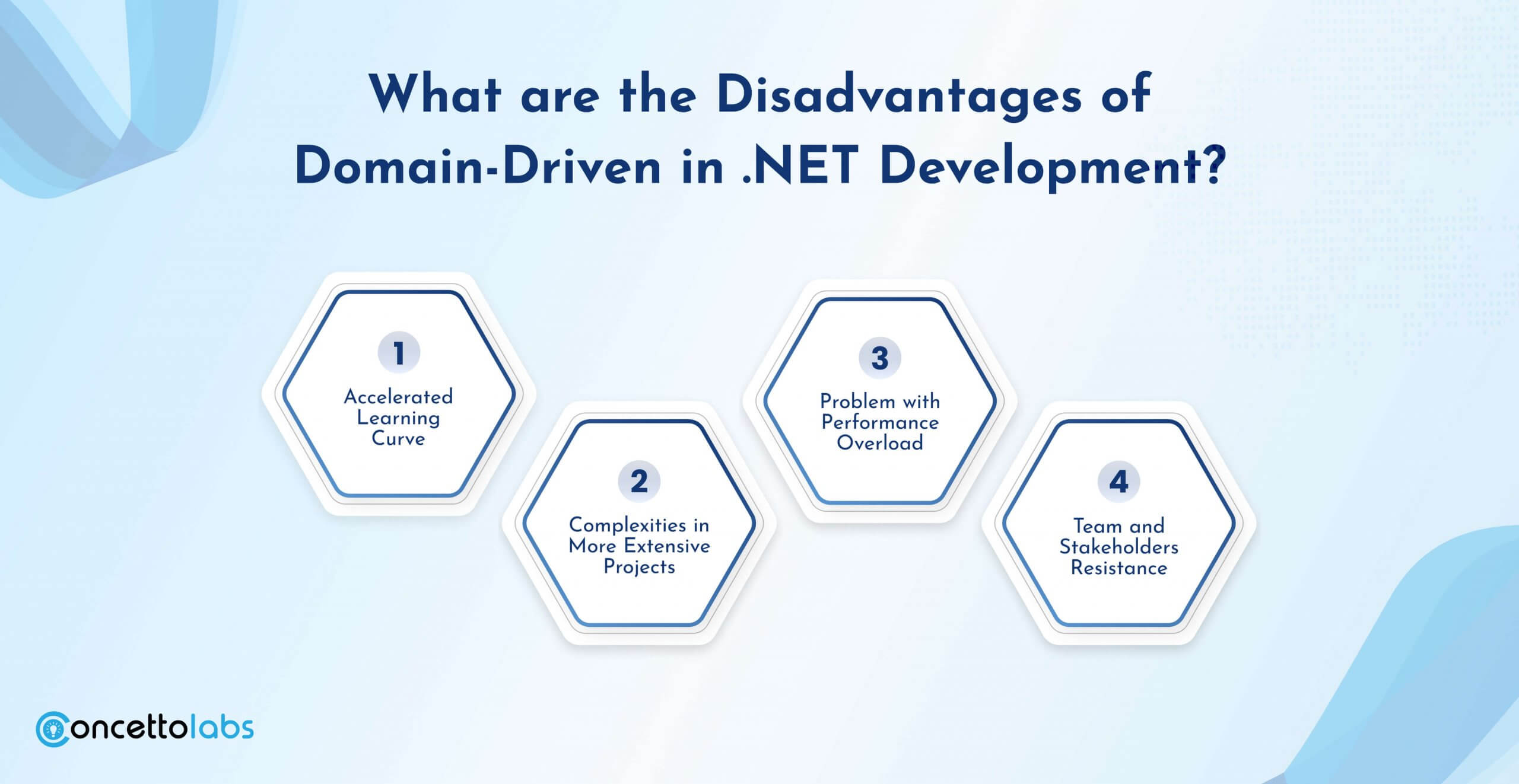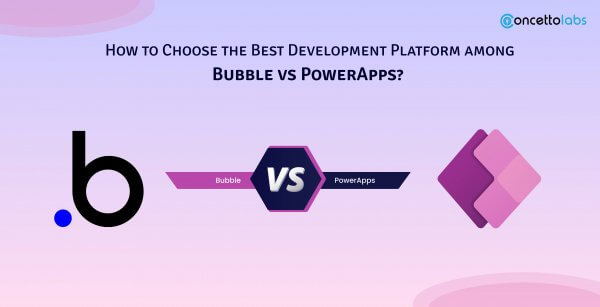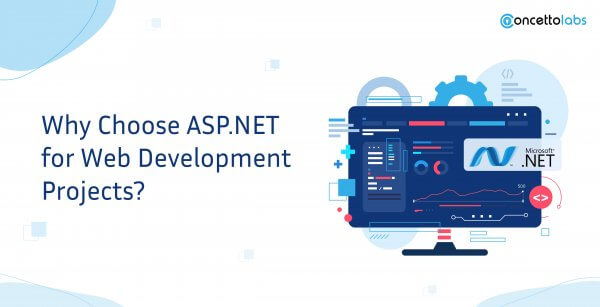Quick Summary: This blog “PowerApps vs Bubble- Choose No-Code Development Platform” compares Microsoft PowerApps and Bubble, highlighting their features, ease of use, customization capabilities, and suitability of different business needs, helping users decide the best app development platform for their projects. Read on the blog to learn more… Businesses now need quick data, choices, and […]
What is the Importance of Domain-Driven Design (DDD) in .NET Development?
![]() By Kalpesh Dave | Monday, April 22, 2024 08:46 AM | 8 min read | 319
By Kalpesh Dave | Monday, April 22, 2024 08:46 AM | 8 min read | 319
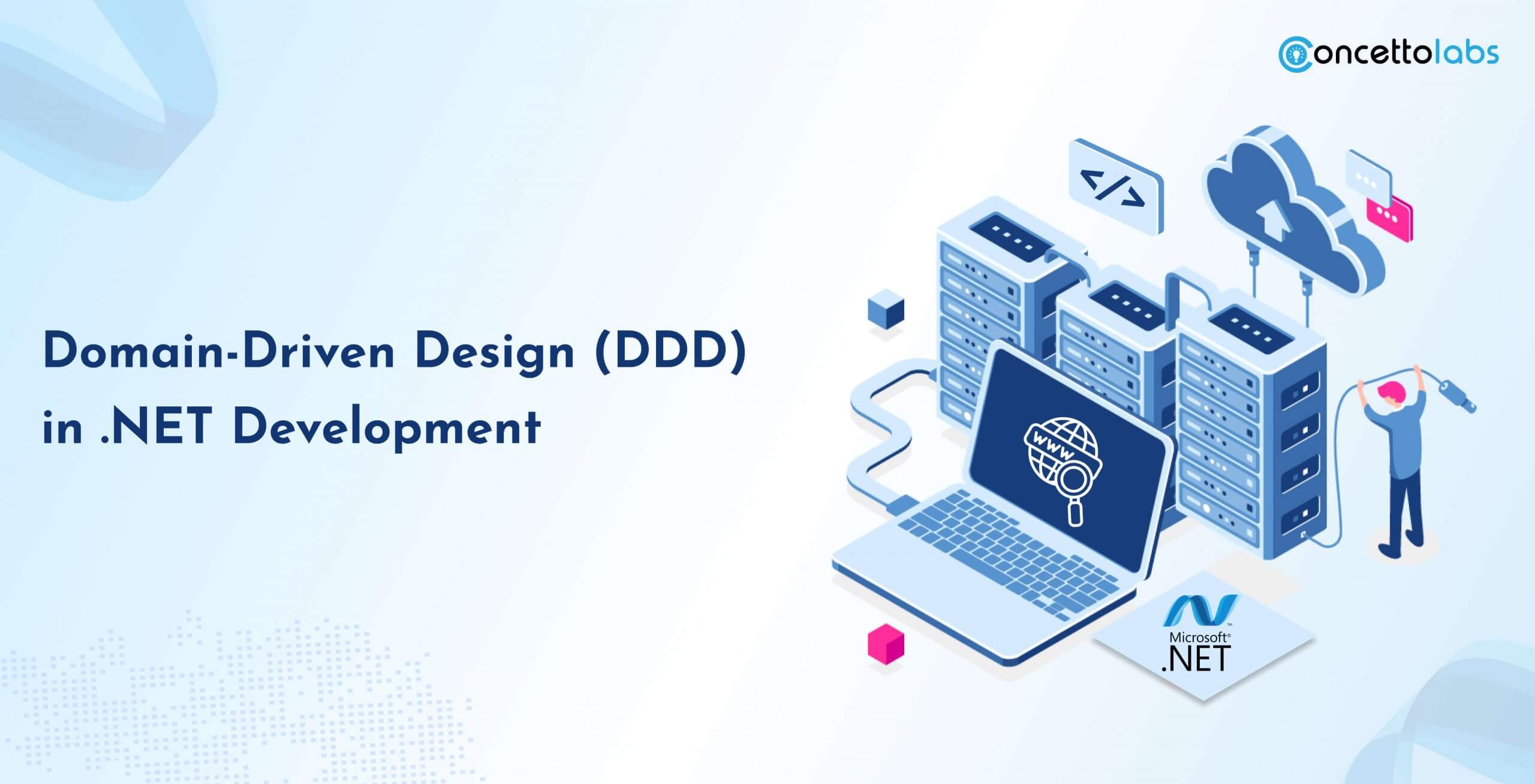
Table of Contents
Summary: Learn why Domain-Driven Design is important for .NET developers in this blog. DDD accelerates structured aligning business logic with code. It enhances scalability, maintainability, and collaboration between domain experts and developers. Use DDD to develop robust, business-centric .NET apps effortlessly.
Developing complex applications for businesses of every industry is a challenging task. This is where Domain-Driven Design plays a crucial role. DDD offers a robust set of principles and practices that assist developers to build software that fulfils every business requirement.
.Net being a versatile and widely-used framework for application development, provides excellent support to implement DDD principles. Developers can prefer to use DDD features like bounded contexts, aggregates, repositories, and value objects through Entity frameworks and tools like Visual Studio, to encapsulate domain logic effectively.
Domain-driven design has a profound impact on .NET development Apps. It helps to get clear and expressive code that reflects the concept of business sample domain mode. This alignment not only enhances communication between developers and domain experts but also simplifies software systems as per the business requirement.
In this blog, we will learn more about Domain-Driven Design, its key concepts, and particular techniques for implementing DDD in .NET app development projects.
Domain-Driven Design is a method of software development that focuses on comprehending and modeling the issues of the domain within which a software system operates or functions. It emphasizes how crucial it is to work closely with the domain experts to gain a thorough grasp of the problems and intricacies of the domain.
For the development team to efficiently capture and express domain concepts in the software designs, Domain-Driven Design and microservices for architect provides a collection of guidelines, best practices, and patterns.
Did You Know?
Domain-Driven Design (DDD) is an idea conceptualized by a developer named Eric Evans in 2004 in his book named Domain-Driven Design: Tackling Complexity in the Heart of Software.
What is Domain–Driven Design?
1. Domain
Domain is the field of the study or issue space the software system intends to solve. It includes all of the ideas, regulations, and procedures from the actual world that the program aims to reflect or assist. For example, banking domain applications contains ideas about accounts, transactions, clients and rules pertaining to banking activities.
2. Driven
Driven suggests that the domain’s requirements and features impact or guide the software system’s design. If we say differently, design decisions are not only motivated by technical considerations or implementation specifics, but also by a thorough understanding of the domain.
3. Design
Design describes the process of putting together a software system’s design or plan. This involves making choices regarding the system’s architecture, the ways in which its parts will work together, and the methods by which the system will meet its functionality and non-functional requirements. When it comes to Domain-Driven Design, the main aim is to develop software that faithfully captures the organization and dynamics of the domain.
Which are the Key Concepts that Relate Domain-Driven Design to .NET?
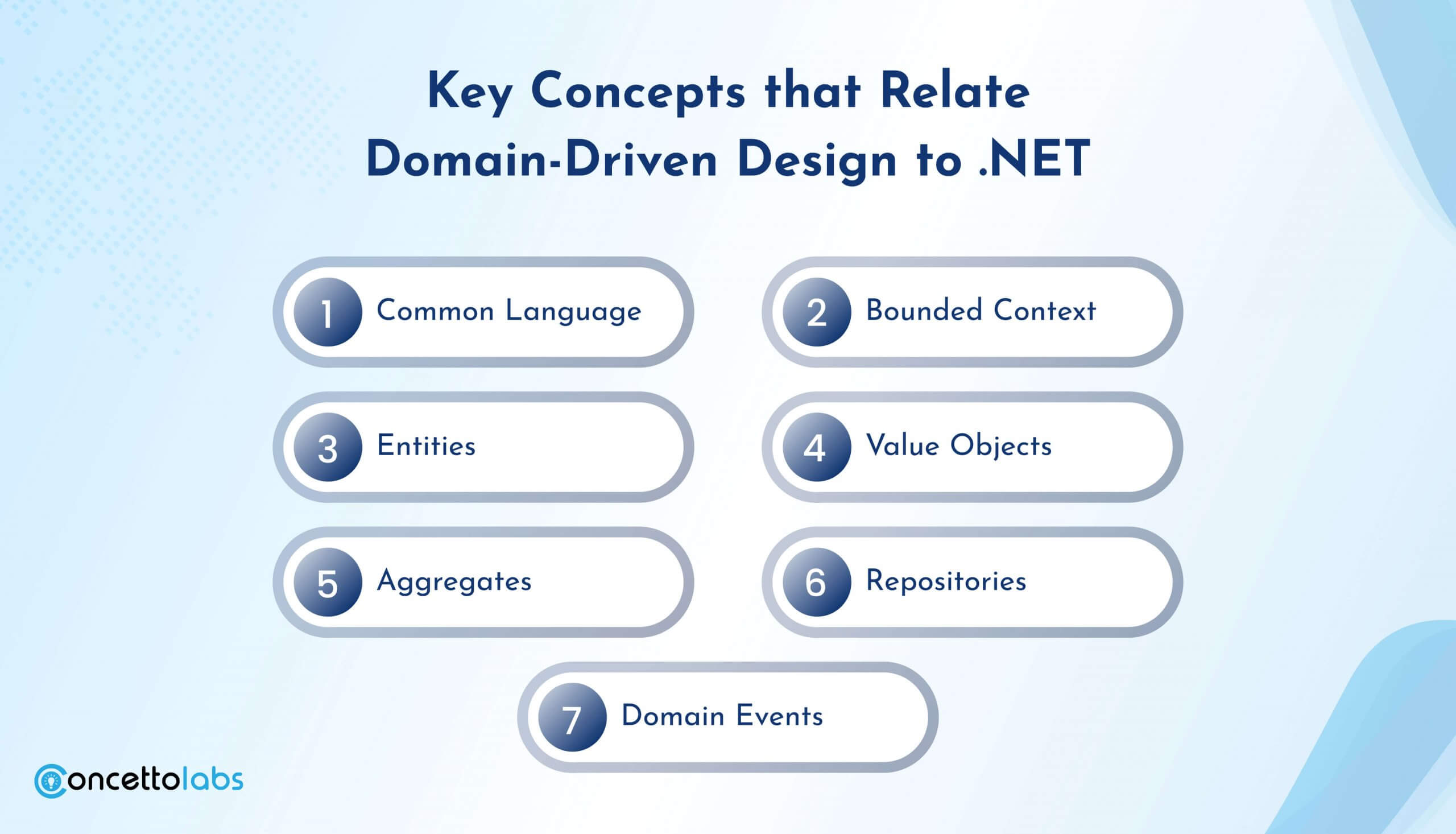
The following are some of the main ideas behind domain-driven design. To ensure that DDD architecture for developers is as straightforward as conventional development approaches, let us check each of them in depth.
1. Common Language
The language that all members of your development team speak together- developers, business stakeholders, and domain experts- is known as the ubiquitous language. It includes terms and concepts that are unique to the business area and appropriately portray it. The use of ubiquitous languages promotes alignment and straightforward communication between technical and non-technical stakeholders, which results in software that is more precise and reliable.
2. Bounded Context
Boundaries inside a model or a subset of models are defined by a bounded context. It establishes the degree of consistency between specific terms, actions, and company policies. A bounded context aids in handling or managing complexity by dissecting intricate systems into smaller, more manageable components. Additionally, bounded context offers a distinct boundary for decision-making and modeling.
3. Entities
Entities are the most basic concepts in any domain, they contain behavior and data. An entity is the most basic sense, an object in a domain that has its own identity and life cycle. Data and actions pertaining to a particular domain-specific idea make up entities. The entities make software administration and control easier since they frequently serve as the cornerstone of a domain model and symbolize the central idea in a business domain.
4. Value Objects
An item in a domain that can be uniquely identified by its attributes alone, such as date, quantity, currency, or value is called a Value Object. A Value Object is immutable and lacks identity, in contrast to an Entity. Frequently., characteristics are used to represent concepts rather than their identity. The frequent use of Value Objects stems from this. A Value Object can also help you simplify your domain model, keep consistency, enhance speed, and prevent duplicate entity references.
5. Aggregates
An aggregate is defined as a group of domain objects, handled as a single entity for data change and consistency. Aggregates carry out intricate tasks automatically and set limits for data changes. Along with the other associated entities and value objects, aggregates also include an aggregate root, serving as the primary entity within the aggregate. In the domain model, aggregators support consistency and transactional integrity.
6. Repositories
The Repositories encapsulate the data access mechanism, allowing the development teams to communicate with the other domain objects without dealing with particular data storage and implementation. By separating the domain model from the underlying data architecture, they aid in the separation of concerns and provide flexibility in selecting the data access approach, making the testing process easy. Also, the repositories can provide a standardized interface for accessing and modifying the domain objects, which enhances codebase maintainability and flexibility in response to data layer modifications.
7. Domain Events
The domain events facilitate communication between various system components by capturing the significant events that occur within the domain. They facilitate loose coupling between components, which helps development teams create systems that are more adaptable and scalable. Additionally, the Domain events provide a way to handle the side effects asynchronously and separated from the primary business logic.
Ready to Enhance .NET Development Skills?
What is the Importance of Domain-Driven Design?
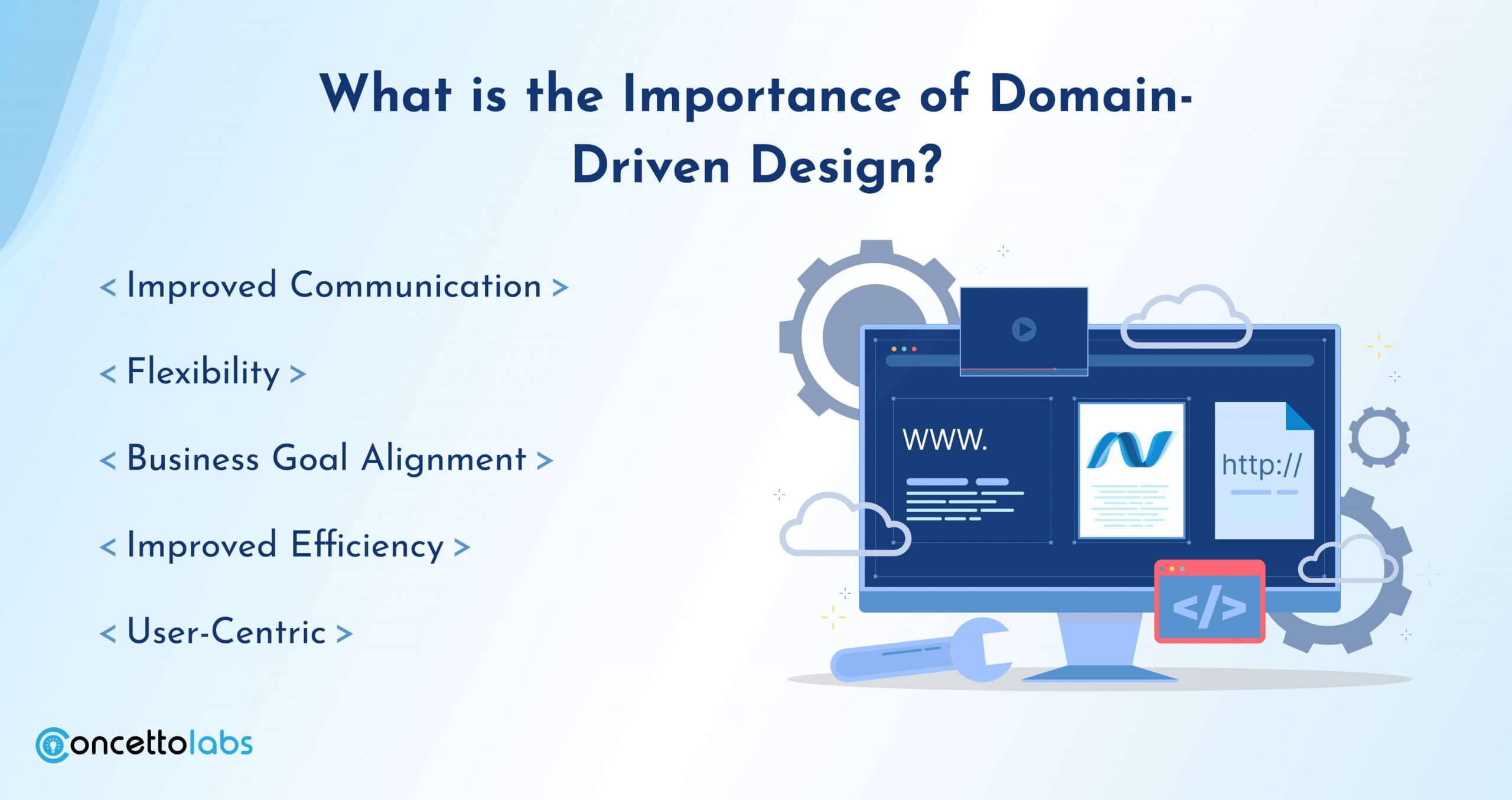
While developing complicated applications, the DDD (Domain-Driven Design) architecture for developers offers various cutting-edge advantages. Using a domain-driven design provides the below advantages:
1. Improved Communication
The Domain-Driven Design’s universal language feature makes it easier for the development team’s non-tech and tech person to communicate with each other.
2. Flexibility
With a modular layout and layers, it will be easy to update your product, modify it, and adapt to meet market standards as demands arise, and that with few unexpected effects.
3. Business Goal Alignment
With utmost clarity and improved consistency on the targeted business outcomes, you will greatly emphasize on developing a product that illustrates how business operates.
4. Improved Efficiency
Your product will perform better in the market and fulfill the requirement when it is developed by an experienced team. With a better working team, experts will get closely involved and it will have fewer features that will be rarely used.
5. User-Centric
When the domain is kept at the forefront of the design process, the final product is better equipped to meet the requirements of the intended users. This makes the domain more fundamental and important than the user experience and user interfaces.
What are the Advantages of Domain-Driven in .NET Development?
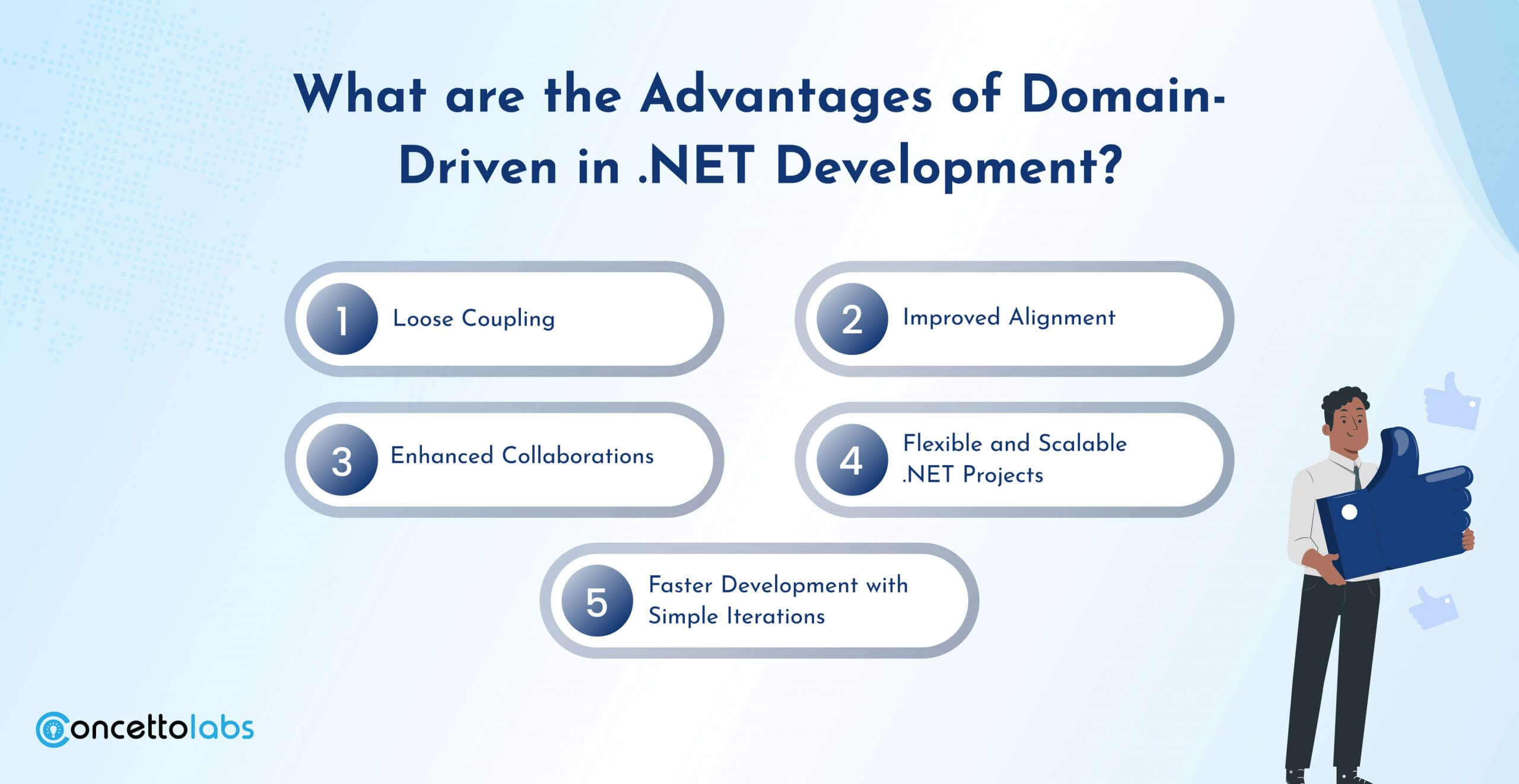
1. Loose Coupling
The system parts will communicate with each other using definitions and principles placed down in the Core layer. Implementations will be done in the other layers. Implementations will be covered in other layers. Executing the implementation will be via DI (IoC, AutoFac) libraries. Hence, the team will grow independently at similar times.
2. Improved Alignment
The primary comprehension and modeling of the domain problem you are attempting to solve are the focal points of the domain-driven design. Developers can better match their software design with the actual requirements of the business by concentrating on the primary business domain. Better solutions and implementations result from this practice’s reduction of the knowledge gap between technical implementation and business understanding.
3. Enhanced Collaborations
The DDD places a strong emphasis on close coordination between the domain experts and non-tech stakeholders, having a good knowledge of the business domain and the team of the developers. Stakeholders and development teams can communicate more effectively when they speak the same language in the domain, which enhances software design and execution accuracy.
4. Flexible and Scalable .NET Projects
It provides an organization method for handling the complexity of software development tasks. DDD aids in creation of adaptable and scalable solutions by dividing the complicated domain into smaller, more manageable components. Large-scale ASP.NET core development of web applications, where the domain may be complicated and dynamic, greatly benefit from it.
5. Faster Development with Simple Iterations
DDD allows for quick development cycles by concentrating on the core domain and iteratively enhancing the domain model. With rapid feature implementation, developers can make iterations based on feedback from stakeholders. Additionally, the clear separation of the domain concepts facilitates faster development by making it simpler to comprehend and alter the codebase.
What are the Disadvantages of the DDD (Domain-Driven Design)?
1. Accelerated Learning Curve
For developers that approach software development in a more traditional manner, the DDD poses a challenging learning curve. Learning the DDD patterns, concepts, and techniques takes time, work, and a willingness to reconsider the accepted methods of the software design. To successfully apply DDD in their project, they must make investments in resources and training, which will have an effect on budgets and schedules.
2. Complexities in More Extensive Projects
Development teams will encounter a significant degree of complexity with the DDD, particularly on the larger projects and those with intricate domain models. The complexity results from the requirement for a deep understanding of the domain and its concepts, which creates difficulty for developers -especially for those not familiar with the methodology. Moreover, maintaining the relationships between the domain entities, repositories, services, and other infrastructure elements can complicate the codebase and make it more difficult to manage.
3. Problem with Performance Overload
The DDD (Domain-Driven Design) delivered an abstraction layer, and the infrastructure by DDD can occasionally lead to a performance overhead, especially when performed carelessly. There are additional computational expenses associated with mapping domain items to databases and managing complicated domain logic, which could impact the overall performance of your application. The performance problems in DDD must be carefully considered and optimized in order to minimize them and keep the benefits of code maintainability and scalability.
4. Team and Stakeholders Resistance
Members of the team and stakeholders who are used to various concepts become resistant when DDD is introduced into ongoing projects or development processes. It is hard to persuade the stakeholders of the DDD that benefit the .NET developers, such as improved code maintainability, scalability, and alignment with your business objectives. Firm leadership, clear communication, and a progressive implementation strategy are necessary to overcome business inertia and take software design into consideration.
Despite these obstacles, if you manage them well, you may successfully use and incorporate the concepts of Domain-Driven Design into your .NET core application development processes.
Conclusion
The clear conclusion says that, by applying the DDD patterns into your project, you may effectively build software projects that appropriately represent the complexity of the issue domain. You may create software systems that are more scalable, easier to manage, and provide significant value to users and stakeholders by learning .NET development. Suppose you are a business owner wondering how to go with your next .NET core developer project. In that case, you can prefer to hire .NET developers and discover the full potential of DDD and witness the difference for yourself.
Start Developing Robust and Scalable .NET Apps using DDD Architecture.
Table of Contents
Kalpesh Dave
I have 13+ exp. in ASP.NET, MVC, C# Opps, Asp.net Core, Anguler12, Web API, LINQ, jQuery, HTML, CSS, Java Script, Telerik, Kendo UI, WCF, Crystal Report, MS SQL Server 2016, Azure Cloud, .NET Framework 4.6 Knowledge of Domain Driven Architecture & 3-Tier, N-Tier architecture as well as GitHub, TFS, SVN version control tools & JIRA & Confluence for project management also knowledge of Agile & DevOps Methodology.
